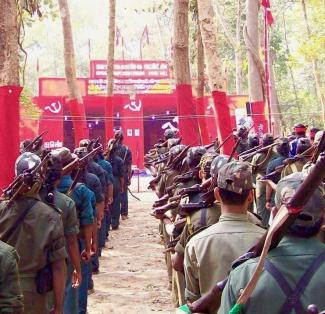Growing Shadow of Red Terror in Orissa
During the mid-1990s, the Naxal Movement (Left Wing Extremism) spilt over to Orissa from neighbouring Andhra Pradesh and the Jharkhand region. Now, the Naxal activities have enlarged to nine predominantly tribal districts, i.e. Koraput, Malkangiri, Nabarangapur, Rayagada, Gajapati and Ganjam abutting the Andhra Pradesh and Sundargarh, Mayurbhanj and Keonjhar districts adjacent to Jharkhand. While the above nine districts remain the Naxal stronghold, the movement has grown stronger in different parts of Sambalpur, Kalahandi, Bolangir, Phulbani, Deogarh, Jharsuguda and Anugul.
However, Naxal threats like abduction and the formation of guerilla squads cropped up in other districts, too. Most recently, the incident came to light when Naxals abducted 18 labourers from the Pudamal and Phulkusum villages of Sambalpur early this year. According to Sushant Nath, the Superintendent of Police of Sambalpur, the Maoists have desperately tried to create a corridor from Jharkhand’s Sarnda forest to the Rairakhol forest in Orissa. Similarly, the Sundargarh police chief, Yashowant Jethua, confirmed in February this year that the Naxals have been able to form local guerilla squads in different areas of Sambalpur and Deogarh.
The Naxals in India have been able to make impressive inroads into the newer areas after the merger of the PWG (Peoples War Group) and MCC (Maoist Communist Centre) on September 21, 2004, to form the Communist Party of India (Maoist). This unification phase was a period of relative calm. However, the beginning of 2005 witnessed major incidents in different parts of Orissa. In February, the Naxalites masterminded a major landmine blast in the Badigeta village of Malkangiri district in which two Policemen were seriously injured in retaliation to the killing of two Naxalites and imprisonment of four cadres by state police. Similarly, in late March, the Naxalites killed a police informer at his home near Rayagada. Again, on April 1, the District Congress President of Rayagada, Satyanarayan Doki, became the victim of this growing ‘red terror’ when the Naxalites looted and attacked his house with explosives. In another dare-devil act, the Naxalites engineered a land mine blast to destroy the Sheshakhol Police outpost in the Rayagada district. These are not only specific incidents of violence but are clear signals of a dangerous Naxal game plan.
Although the Naxal Movement in Orissa gained momentum and strengthened its position during the last two decades, the Andhra government’s proscription of the Movement itself in the 1990s had a far-reaching impact on otherwise violence-free Orissa. Hitherto sporadic in nature, Violence intensified in the Naxal-affected areas of Orissa after the PWG formed the Andhra-Orissa Border Special Zonal Committee (AOBSZC) in 2001.
The cause of this spread in predominantly tribal districts is due to the poor socio-economic conditions of the tribal people. During the last couple of years, hundreds of sponge iron factories have come up in different parts of Sundargarh and Keonjhar. These factories were set up against the wishes of the tribal people, who are primarily forest-dependent communities. It is easier for the Maoists to exploit the anger and frustration of the local tribal against the state. For instance, Sabyasachi Panda, one of the top guns of Naxal leadership in Orissa, has locked horns with the Orissa Government over the Bansadhara Dam Project. In an interview in March, Panda demanded immediate change of the dam site from Katragoda village in Andhra Pradesh to Gunupur area of Orissa. Similarly, the state government’s failure to rehabilitate the affected people of the Balimela project in the Malkangiri district has remained a prime cause for the locals getting closer to Naxal.
Over the years, the PWG has managed to develop several frontal organizations for tribal, women, and cultural artists. On the other hand, the erstwhile MCC has consolidated its position in the districts of Sundargarh, Keonjhar and Mayurbhanj. Earlier, these areas were used as hideouts by the ultras from the neighbouring Jharkhand, but recent incidents suggest something alarming. In January last week, there was a major exchange of fire between the Orissa Police and the Naxal group on the Orissa-Jharkhand border near K-Balang, which left one senior police officer seriously injured. Earlier, the Orissa Police used to claim that there were no local recruitments to Naxal groups in these areas, but the subsequent arrest of some Naxal cadres speaks otherwise. Jaraikela, Bisra, Gurundia, and Bonai are the areas in Sundargarh which have now become the real bastions of the former MCC. Meanwhile, the Naxals have conducted several training camps in the dense forests of Deogarh and Rairakhol.
Although Orissa has a long history of Naxal activities, there is no coherent strategy to deal with the issue. However, of late, a series of programmes have been declared by the government to win over the tribal and to fulfil decade-old demands of the rural, underdeveloped people of Orissa in the Naxal-infested areas. But any letup or half-hearted attempt from the government now would only worsen the problem. The government must develop a long-term strategy to put an end to the decades-old violence. For this, government agencies and the fruits of democracy must reach the affected areas and the neglected people. This is no easy task.
